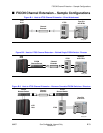
96257 Sun Confidential: Internal Only C-85
Revision A
Glossary
A
AC. Alternating current. Current in which the direction is
reversed, or alternated, 60 times per second (50 times
per second in some countries). Contrast with direct cur-
rent.
acceptance test. A formal test done by a system end-
user to determine if a system works according to specifi-
cations and should be accepted.
access density. A measure of I/O activity; the number of
I/O operations per gigabyte of functional capacity per
second.
access privileges. The extent to which a user may op-
erate a system resource on a host, network, or file serv-
er. In many cases, permission to access a host, network,
or file server, view its contents, and modify or create files
is limited by a system administrator to maintain security.
ACMI. VSM-VTSS cache memory interface card.
AC power redundancy (ACPR). An AC power system
that provides dual AC power sources to prevent power
interruptions and loss of access to data. If one power
source fails, the other (redundant) source supplies all
power to a subsystem until the failed unit is replaced.
ACS. Automated Cartridge System. Also library
or tape
library. A system that automatically mounts cartridges in
tape drives in response to requests from host software.
ACSLS. Automated Cartridge System Library Software;
Automated Cartridge System Library (Unix) Server.
actuator-level buffer (ALB). Solid-state memory asso-
ciated with an actuator in a storage device. In VSM,
ALBs minimize rotational latency in disk drives and allow
non-synchronous data transfer between the front-end
cache and back-end disk array drives.
address. (1) A hexadecimal number that represents an
identifying location for a device or an area of storage; for
example, a memory register, disk sector, or network
node. (2) An identifier for a communication port. (3) The
act of communicating with a storage device.
ADC. Analog-to-digital converter.
ADT. Automatic data transfer.
AFO. Americas Field Operations. Acronym for all Sun
StorageTek U.S./Canada field operations.
AIX. Advanced Interactive eXecutive. The IBM version of
Unix.
ALB. See actuator-level buffer
.
algorithm. A detailed, ordered set of instructions for
solving a problem. When used in computer program-
ming, term refers to instructions given to a computer.
allocated array cylinder. An array cylinder that contains
current or non-current user data.
alphanumeric. A system of notation which utilizes al-
phabetic letters, numbers, and special characters.
AME. Advanced Manufacturing Engineering. At Sun
StorageTek, an engineering group that manufactures
product prototype machines, typically through the EPE
phase of a product development cycle.
AMT. Automatic migration threshold. User-defined per-
centage values that determine when virtual tape volume
migration begins and ends. VTV migration begins when
the VTSS buffer reaches the high AMT and ends when
the buffer reaches or falls below the low AMT. These
thresholds apply to all VTSSs.
analog. A means of representing data in continuously
variable physical quantities, in contrast to digital repre-
sentation of data in discrete units (binary digits 1 and 0).
Analog systems handle information that is represented
by continuous change and flow, such as voltage or cur-
rent. Contrast with digital
.
ANSI. American National Standards Institute. An organi-
zation that establishes procedures by which accredited
organizations create and maintain voluntary industry
standards in the U.S., including those for the computer
industry. ANSI is the U.S. member of the International
Electrotechnical Commission (IEC) and the International
Organization for Standardization (ISO).
ANV. VSM-VTSS nonvolatile memory storage card.
APL. Assembly parts list.
application. A software program designed to perform a
specific task or group of tasks, such as word processing,
communications, or database management.
array. A group of storage devices controlled in such a
way as to provide higher data transfer rates, higher data
availability, and data redundancy. An array is typically
treated as a single volume by a host operating system.
array architecture. A class of magnetic disk architec-
ture in which several physical devices emulate (typically)
fewer virtual devices of (typically) higher capacity and
performance.
array cylinder. A collection of all physical cylinders in a
dual-redundancy array with the same physical address
(CC, **). VSM allocates back-end space in units of array
cylinders, which are either free or allocated.
array track. A collection of all physical tracks in a dual-
redundancy array that have the same physical track ad-
dress (CC, HH).
ASAL. Alternate Sector Assignment List.
ASCII. American Standard Code for Information Inter-
change. A protocol for displaying characters and trans-
ferring data between computers and associated equip-
ment. ASCII codes are numbers from 0 to 255. Numbers
0 to 32 are non-printing control codes; 33 to 127 are for
letters and punctuation; 128 to 255, called extended
characters, can be used for a variety of purposes, but
are most commonly used for accented letters, graphics,
and other special characters.
ASIC. Application-specific integrated circuit. A custom-
ized microchip designed for use on a particular circuit
board, or for a specific application.
ASM. Application Storage Manager. A Sun StorageTek
high-performance file system with hierarchical storage
management (HSM) functionality, available for Solaris
and NT platforms.
ASU. Advanced Site Unit. Hardware component of the
Sun StorageTek Service Delivery Platform (SDP) remote
support software.


















